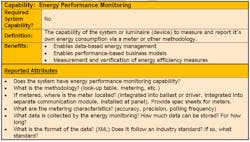First draft of a controls specification is out for review and will be the basis of a qualified products list that will likely be adopted broadly by utilities and other market-transformation initiatives.
The DesignLights Consortium (DLC) has announced publication of the first draft of a Networked Lighting Control System Specification that will ultimately become the basis of a qualified products list (QPL) that will gate access to rebates and other incentives. The controls specification draft is easily accessible on the DLC website, and the DLC is asking stakeholders to submit comments and suggestions about the draft by September 29.
Interested in more articles & announcements on standards and controls specifications?
The new controls specification isn’t specific to solid-state lighting (SSL) but LED-based products generally enable luminaire developments with superior adaptive- and network-control features. The intent of the new specification is to identify lighting products that comply with the Luminaire Level Lighting Control (LLLC) concept identified by the Northwest Energy Efficiency Alliance (NEEA). The NEAA is an alliance of more than 140 utilities located in the northwest of the US; the LLLC concept essentially implies that luminaires must have controls and sensors integrated into each luminaire as opposed to installed at the room or a larger level.
The DLC controls specification builds on the LLLC concept and will ultimately include an accepted list of network standards. The first draft simply states the mission of a focus on open and mature standards. The expectation is that multiple standards will be adopted as suitable with products identified on a QPL for each.
What the initial draft defines is the types of capabilities that will be required in luminaires or that manufacturers might add at their own option. Indeed, the specification uses the words "required" and "reported" to segment the feature set.
The required set of features includes:
- Networked
- Zoning that is reconfigurable with layering
- Occupancy sensing
- Daylight harvesting
- Task tuning with high end trim
- Continuous dimming
- Security
- GUI (graphical user interface) control
Obviously, the reported optional features will be up to the manufacturers. But some examples include load shedding, energy performance monitoring, preventive maintenance features, standby power, and personal control via a device such as a smartphone.
Ultimately, the required and reported attributes will be closely linked. The draft points out, for instance, that the required list includes the need for an occupancy sensor but does not specify the type. A manufacturer would identify the type in the reported attribute set.
Dimming is another area in which a manufacturer would need to identify attributes for both lists. For example, the required list might include 0-10V dimming that complies with IEC60928 Annex E or phase cut dimming that complies with NEMA SSL 7A. The reported attributes might define the dimming curve used and whether that curve is configurable by the lighting specifier/designer.
The DLC has already developed a robust list of reported attribute types. Moreover, the draft includes examples of the types of items that might be reported relative to things like remote diagnostics or plug load control.
The DLC was formed within the Northeast Energy Efficiency Partnership back in 2009. The first QPL was publicly released in 2010. Arguably the US Environmental Protection Agency (EPA) Energy Star program is more broadly used in incentive programs, but the DLC covers a far broader range of products. For example, Energy Star does not address LED-based T8 tubes but DLC does. And most SSL product manufacturers seek DLC recognition.






